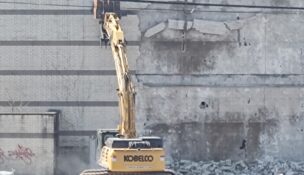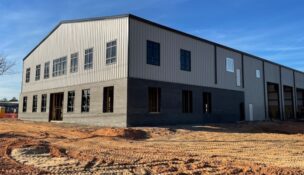Historic renovations present distinctive challenges, rewards
Melinda Waldrop //December 6, 2019//
The head in the car came as a surprise.
The process of renovating historic buildings can often produce unexpected finds. But an Upstate spinning mill that Columbia-based Lambert Architecture and Construction Services is transforming into apartments provided a real doozy.
“There was this old antique car that was parked in what was the engine house, where they had their boiler,” recalled Lambert project architect and corporate associate Josh Bucher.
After its incarnation as a mill, the 300,000-square-foot building had been used to store beauty supplies, and its five stories were filled with lipsticks, hairspray and the like. Poking around the dark, mildewed space, Bucher and Lambert president Scott Lambert shined flashlights on the abandoned automobile.
“Scott about jumped out of his skin, because he looked in the car and there was a mannequin head in there,” Bucher said. “It’s stuff like that that you’re just not expecting.”
While most historic projects aren’t quite so scare-inducing, they can be time-consuming, detail-oriented tasks that those with experience overseeing them say require patience and flexibility.
“You’ve got to have a sense of humor and not be in too much of a hurry, because they tend to take a little longer,” Bucher said. “These projects are fun, but they get pretty complicated pretty quickly, too. With that in mind, you’ve just got to have a good team involved, and an understanding client. These projects are definitely hard to estimate, both time- and money-wise.”
Forging a balance
The paperwork involved in applying for the tax credits such projects are often eligible for can pile up, and some such credits require painstaking documentation and replication. Modern construction and design solutions may not be the best fit for centuries-old properties, and finding, say, a wrought-iron worker is not always simple.
That’s one challenge Lambert faced in the third stage of renovations at the Hampton-Preston Mansion and Gardens, a downtown Columbia landmark. As part of an in-depth project that has included reinterpreted exhibits and spruced-up gardens, a basement that was part of the original structure was excavated and turned into a multi-level event space.
A central design element is a sweeping staircase with dual entry points meeting in a columned marble balcony trimmed in wrought iron.
 “There are historic elements that we wanted to recreate, but modern trades and materials — it’s just way too expensive much of the time to go back and hammer wrought iron, so we were trying to find that happy medium to where it doesn’t look manufactured,” Bucher said. “What I find fascinating about these historic projects is really the story that they have, and materials in particular kind of help tell that story.”
“There are historic elements that we wanted to recreate, but modern trades and materials — it’s just way too expensive much of the time to go back and hammer wrought iron, so we were trying to find that happy medium to where it doesn’t look manufactured,” Bucher said. “What I find fascinating about these historic projects is really the story that they have, and materials in particular kind of help tell that story.”
Lambert located a Charleston blacksmith to hand-forge some of the more intricate and visible pieces, including the staircase railings.
“However, a lot of the stuff you don’t touch or really see was more manufactured, or cut out of steel plates,” Bucher said. “There’s definitely some back-and-forth, and it can be a little frustrating, because you have something in your mind and you know where you need to get, but it’s hard finding people that can do a lot of this stuff anymore. … It is a balance between trying to make something modern but also give it that crafted touch.”
Columbia-based Hood Construction Co. also worked on the Hampton-Preston Mansion and has handled several such historic renovations, including 701 Whaley Street, a former community center for mill workers that was transformed into a premier area events center.
“Each one is very different,” said Margaret Colquitt, Hood vice president of business development. “They’re all built in different eras, and also built with different styles.”
The work on the Hampton-Preston Mansion, which included careful archaeological excavation, continued Hood’s longstanding relationship with Historic Columbia, a preservation organization that also maintains the Robert Mills House, a National Historic Landmark across the street from Hampton-Preston.
“Historic restoration, from a constructability and architectural and engineering perspective, has a lot of hand-holding,” Colquitt said. “It takes a lot of background knowledge of construction as well as being able to keep things in budget, keep things under control, and protect the elements that the historic preservation entities wish to protect and require to be protected while you also update and bring a new structure to life for an investment purpose and a revenue-producing purpose.”
John Sherrer, Historic Columbia’s director of cultural resources, said the excavated event space has served as a site for weddings and parties since being completed in May, while the renovated basement has provided badly needed classroom space.
“We get a lot of different visitors here,” he said. “We’re just trying to make the site as nimble as possible and as flexible as possible to accommodate those various needs.”
Careful excavation revealed some surprises even to Sherrer, who wrote his college thesis on the property. One of the most visible is a large cistern that provided the mansion, home to wealthy Columbia merchant Ainsley Hall and wife Sarah before being sold to Wade Hampton I in 1823, with fresh water.
“You start exploring some of these old buildings, and you never know what you’re going to find through the next door,” Bucher said.
Rich rewards
Colquitt said the initial conditions encountered in historical projects can run the gamut from well-maintained to the bowed walls and collapsed second floor awaiting renovators at 701 Whaley.
“You had open air, with vegetation growing in, on one side of the building, (and) a basement that was largely full of water,” she said. “The fire marshals and building officials did not want it to be entered by human beings. We had to work with them and the engineers to go in and safeguard the structure.”
Hood has overseen projects throughout the state, from the Planters Inn in Charleston to Clemson University’s Barnes student center, site of a former sheep barn. “That was the oldest agricultural building still standing on Clemson University’s campus,” complete with animal stalls, when Hood first investigated it, Colquitt said.
Hood helped transform the building into a bustling center of student activity with a coffee bar and an outdoor piazza.
“It’s very gratifying for our company to go into these kinds of structures and at the end of the day, go back and look and see the kind of life that got breathed into them,” Colquitt said.
While she said picking a favorite project would be impossible, Colquitt said one of the most satisfying was the renovation of Trinity Episcopal Cathedral. Hood had planned a few months’ worth of upgrades in advance of Trinity’s 2012 bicentennial before a discovery of termites led to a two-and-a-half-year commitment.
Colquitt said the work, which included restoration of the cathedral’s intricate wooden pew doors, was made easier by some of the 65 craftsmen Hood employs.
Perhaps more than specific structures, Colquitt and Bucher take pride in the community revitalization historic renovation and reuse projects often foster.
“When my parents come in town, I like to drive them around and point out things,” said Bucher, whose company also worked on The Grand, a boutique bowling alley and restaurant that gave a former Army/Navy store on Main Street a new life. “It’s fun for me to discover the history of these buildings and try to tell it in some way. In addition, I like the idea of kind of adding our own chapter to the narrative of the building itself.
“The reward is when people start to notice these old buildings that they didn’t really notice before.”
a















